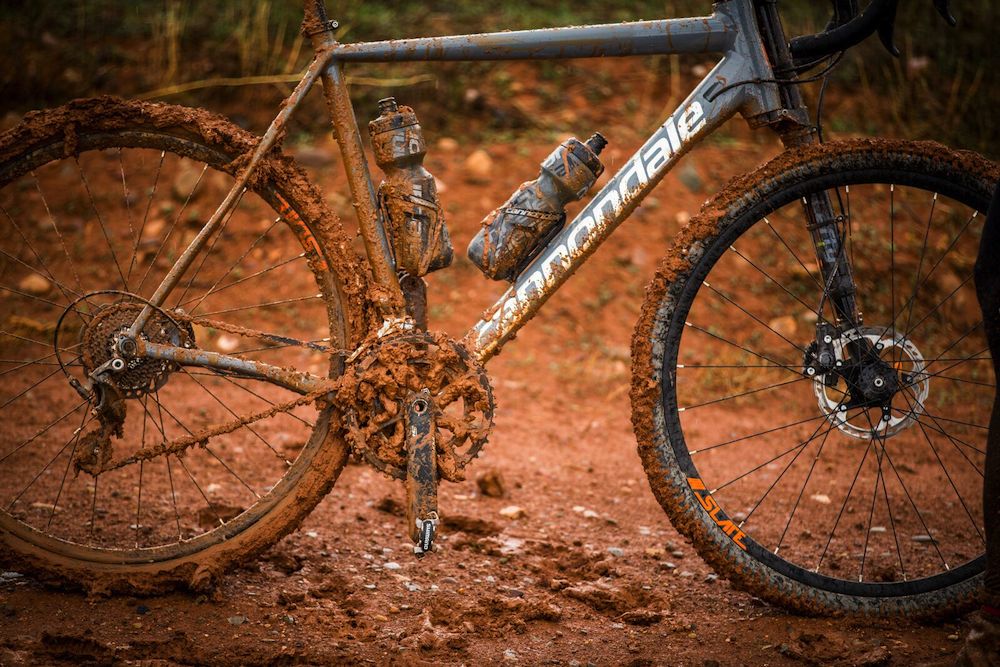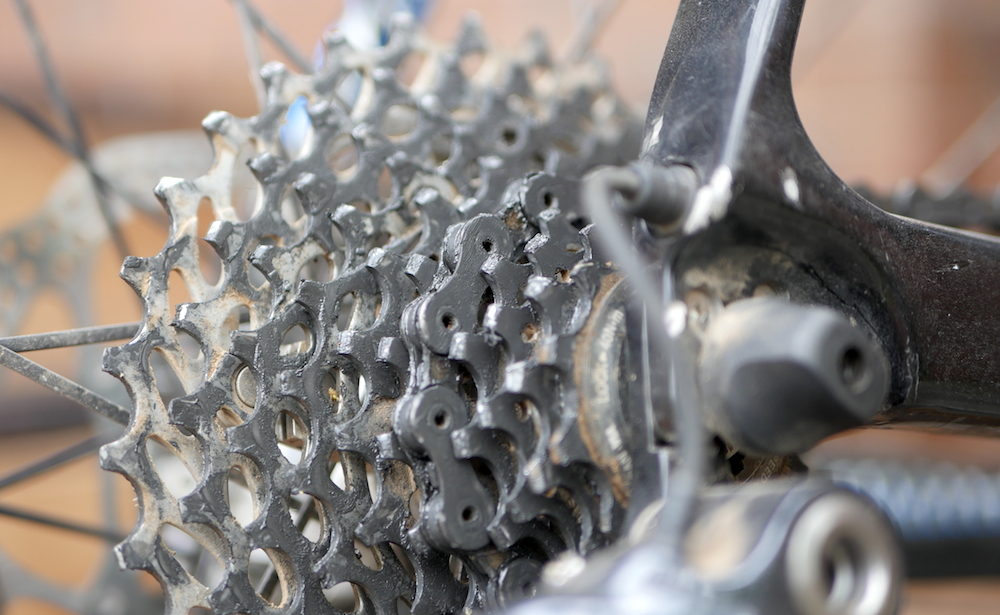Table of Contents
There are around 40,000 articulations per minute on a bicycle chain as it snakes its way through your derailleur and around your sprockets. Each of these chain link articulations is a source of friction, which ultimately slows you down.
The efficiency of a clean and lubricated derailleur drivetrain is usually upwards of 97%. This simply means that 97% of the power that you put into the pedals is going into driving your rear wheel, and the remaining 3% is lost to friction.
The drive efficiency varies with the lubricant used, the quality of the drivetrain components, how worn the components are, the front and rear sprocket sizes, the chain angle, the chainring tooth shapes, the chain link shape, the rear derailleur’s one-way clutch design, the jockey wheel sizes, the power output and cadence of a rider… and more! A combination of these variables is why we see frictional differences between 1X drivetrains and 2X drivetrains.
The drive efficiency also varies significantly depending on the chain ‘dirtiness’ where the type of grit, amount of grit, and amount of lubricant left all play a role.
With all of these abovementioned variables, knowing exactly how much a ‘dirty chain’ slows you down is an impossible task. However, the following data should give us a good idea.
Note: the cover photo is by Tim Bardsley-Smith from when I biked the Mawson Trail.
How Do We Determine Drivetrain Efficiency

The drive efficiency data that we will be discussing was collected about a decade ago by Friction Facts, an independent test lab. I’ve previously analysed Friction Facts data in my articles that looked at the efficiency of belt drivetrains (the most recent belt data is found HERE) and 1X vs. 2X drivetrains.
All tests were conducted using a special test rig with a chain tension simulating 250 watts of power output. The cadence was set to 90 RPM. Each chain was run for five minutes, with data captured at the end of each five-minute run. When the chains were installed and removed from the test rig, they always faced the same direction.
The test rig is accurate within +/- 0.02 watts, and system losses from the four ceramic bearings in the equipment have been subtracted from the final results.
The Efficiency of A Dirty Bicycle Chain – Test #1
In this first test, a perfectly clean chain with a light oil-based lubricant ran at 97.6% drive efficiency.
The efficiency dropped by 2.8% after a test period in the rain*, and it was 3.2% less efficient with some wet mud contamination. Once the mud contamination had dried, the efficiency had dropped to 92.8%, which means that almost 5% more of your pedal power is now being lost to the dirty drivetrain.
*Unfortunately, details about the test period duration or conditions were not made available.
The Efficiency of A Dirty Bicycle Chain – Test #2
Friction Facts conducted a different test using six participants at a bicycle race in Boulder, USA. The chains were tested both before and after the one-hour cyclocross race to determine their drive efficiency after grit exposure.
Three participants were given Ceramic Speed UFO V1-treated chains, which are coated with a hot wax that dries onto the chain and provides lubrication. The other three participants used more common light oil-lubricated chains.


After the race, Friction Facts found the wax-treated chains lost an average of 0.7% drive efficiency, while the oil-treated chains lost an average of 1.7%. The likely reason for the difference here is that the wax lubricant simply collects less grit and even provides a barrier to stop it from entering the chain links.
The Efficiency of an Unlubricated Chain Drivetrain
The noise of a bicycle chain is usually a good indicator that additional friction is being experienced. After all, chain links are metal-on-metal so they need some form of lubrication to run smoothly.
What happens to the drive efficiency when you have no lubricant left on your chain? I’m glad you asked.

For this test, six different chains were perfectly cleaned and applied with a light oil-based lube. When they were put on the test rig, the drive efficiency exceeded 97% in all cases.
Next, the six chains were stripped back to bare metal with an ultrasonic cleaner. The drive efficiency was re-tested and was found to be as low as 89.6% and as high as 92%.
When we average out the decreases in efficiency we find that 6% of your pedal power is being lost when you don’t have any chain lubricant left. Even a dry muddy chain with a bit of lubricant works better than a chain without any lube!
Try to remember this next time you’re dealing with a squeaky chain…
How Much Does A Dirty Chain Slow You Down?
Using Bike Calculator, we can now simulate the speed differences between a perfectly clean and lubricated chain, and a chain of varying ‘dirtiness’. I will be using the Friction Facts data from the first test, and an average of the data from the unlubricated chain test.
Let’s assume our rider, bike, and equipment weigh a total of 85kg (187lb). The rider is on a gravel bike with their hands in the brake hoods.
Simulated Average Speed On Flat Gravel Terrain (250-Watts):
Clean and Lubed – 31.38km/h
Rainy and Lubed – 30.99km/h – 1.2% Slower
Wet, Muddy and Lubed – 30.94km/h – 1.4% Slower
Dry, Muddy and Lubed – 30.71km/h – 2.1% Slower
No Lubricant – 30.53km/h – 2.7% Slower
The differences in cycling speed are perhaps not as large as you’d think. This is because wind resistance and tyre rolling resistance are usually the two biggest forces that you work against on a bicycle.
Depending on the chain ‘dirtiness’, the reduction in cycling speed works out to be between 1.2% and 2.1%. And using a chain with no lubricant at all makes the bike almost 3% slower!
As the Friction Facts lab test was conducted at a power output that’s higher than that of the average cyclist, let’s run a simulation at a more suitable power output of 150 watts.
Drivetrain friction reduces linearly according to data shown in the belt drive test. This has allowed me to estimate a 31% reduction in friction for each chain condition when we drop from a power output of 250-watts to 150-watts.
Simulated Average Speed On Flat Gravel Terrain (150-Watts):
Clean and Lubed – 24.75km/h
Rainy and Lubed – 24.36km/h – 1.6% Slower
Wet, Muddy, and Lubed – 24.30km/h – 1.8% Slower
Dry, Muddy, and Lubed – 24.07km/h – 2.7% Slower
No Lube or Contamination – 23.88km/h – 3.5% Slower
The differences in speed are a bit larger with a lower power output. This is mostly due to the reduction in wind resistance. We now see a speed reduction of 1.6% to 2.7%, depending on the chain condition. And your speed could be 3.5% slower if you forget to lube your chain!
Summary
This data shows that a dirty bicycle chain can be anything from 92.8% to 96.8% efficient (depending on the contamination) and this can reduce one’s cycling speed by approximately 1% to 3%.
We see bigger differences in cycling speed when we test the aerodynamics of different luggage setups and the rolling resistance of different tyres.
That said, keeping your chain clean and lubricated is not a difficult task. When your drivetrain is running well, you will not only go faster, but your bike will be quieter, and you will experience less wear on your drive components – saving you money.








